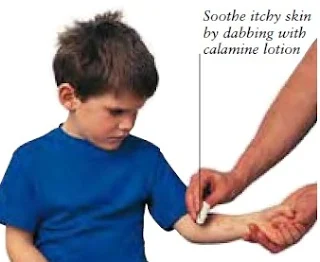When looking after a sick person at home, whether a child or an adult, your main concerns will be to ensure that he or she is comfortable and drinking plenty of fluids, that you provide the correct medication at the right time, and that any new or worsening symptoms are dealt with correctly. A sick child or baby can be more demanding, but loving, patient care is one of the best aids to recovery.
Check temperature
• A fever is a body temperature that is above 100.4°F (38°C). See pp.68 and 70 for advice on the different ways of measuring a temperature.
• If you or your child develops a fever, look at the charts on pp.74 and 76 to check whether medical
help is required or whether the cause can be treated at home.
Relieve fever
• Drink plenty of cool fluids.
• Reduce temperature and relieve discomfort with an over-the-counter analgesic such as acetaminophen.
• Give babies over 3 months of age and children under 12 years liquid acetaminophen (not aspirin).
• Cool young children by removing most of their clothing, wiping them with a washcloth moistened
with tepid water, and fanning them, but do not let them get too cold.
• Children under 5 years old are susceptible to febrile seizures (p.43) if they have a high fever
and should be watched very closely.
• Do not give milk to adults, children, or bottle-fed babies if they are suffering from diarrhea or vomiting.
• If a breastfed baby is affected, continue to breastfeed and offer the baby extra fluids.
• Alternative methods are to rub a vapor ointment on the chest or to use decongestant capsules that are filled with menthol and other strong-smelling oils.
Important
• Do not give steam inhalation treatment to young children.
• Older children should undergo steam inhalation treatment only if supervised
Check temperature
• A fever is a body temperature that is above 100.4°F (38°C). See pp.68 and 70 for advice on the different ways of measuring a temperature.
• If you or your child develops a fever, look at the charts on pp.74 and 76 to check whether medical
help is required or whether the cause can be treated at home.
Relieve fever
• Drink plenty of cool fluids.
• Reduce temperature and relieve discomfort with an over-the-counter analgesic such as acetaminophen.
• Give babies over 3 months of age and children under 12 years liquid acetaminophen (not aspirin).
• Cool young children by removing most of their clothing, wiping them with a washcloth moistened
with tepid water, and fanning them, but do not let them get too cold.
• Children under 5 years old are susceptible to febrile seizures (p.43) if they have a high fever
and should be watched very closely.
SOOTHING A SORE THROAT
• Rest your voice by speaking as little as possible.
• Drink plenty of fluids, especially hot or very cold drinks.
• Eat ice cream and icicles; they help ease a tickly throat.
• Take analgesics, such as acetaminophen or ibuprofen, in the correct doses.
• Suck throat lozenges containing a local anesthetic (these are suitable only for adults).
• Gargle warm salt water (half a teaspoon of salt in a glass of water).
• Install a humidifier or place bowls of water near radiators to keep the air moist.
RELIEVING ITCHINESS
For itchiness caused by dry skin, moisturize the skin by applying emollients, such as aqueous cream
and petroleum jelly, after washing and bathing.
• To soothe severe itching caused by chicken pox, apply calamine lotion to the spots.
• For severe itching, apply topical corticosteroids sparingly to the area. Always follow the manufacturer’s instructions with corticosteroids.
PREVENTING DEHYDRATION
• If you have a fever or are suffering from vomiting and diarrhea, drink plenty of fluids every 1–2 hours, such as diluted orange juice, weak sweetened tea, or an over-the-counter rehydration solution, which contains essential minerals and glucose.• Do not give milk to adults, children, or bottle-fed babies if they are suffering from diarrhea or vomiting.
• If a breastfed baby is affected, continue to breastfeed and offer the baby extra fluids.
RELIEVING A BLOCKED NOSE
• Fill a bowl or basin with hot water and lean over it with a towel pulled over your head. Breathe deeply.• Alternative methods are to rub a vapor ointment on the chest or to use decongestant capsules that are filled with menthol and other strong-smelling oils.
• Do not give steam inhalation treatment to young children.
• Older children should undergo steam inhalation treatment only if supervised










0 Comments
కామెంట్ను పోస్ట్ చేయండి